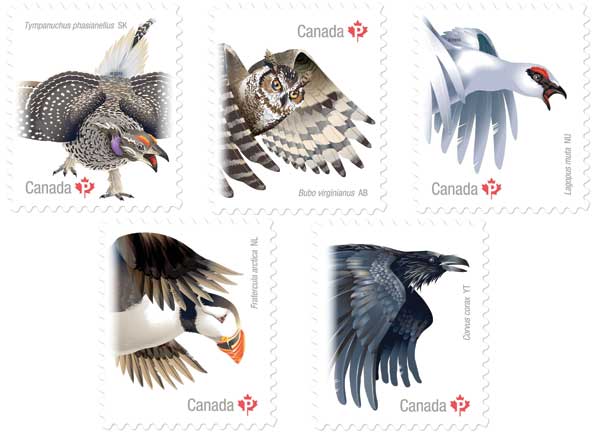September 02, 2016
Posted in News Releases
Canada Post launches Birds of Canada stamp series
Richly detailed illustrations capture birds in dynamic poses
September 02, 2016
Posted in News Releases

OTTAWA – The common raven, featured in Canada Post's new Birds of Canada stamp series, has some uncommon traits: it can mimic other birds, improvise tools to obtain food, engage in impressive aerial displays, and has remarkable puzzle-solving skills.
The five-stamp set also features the Atlantic puffin, the rock ptarmigan, the sharp-tailed grouse and the great horned owl. Each bird is depicted in a characteristic pose.
Recently unveiled, the stamps are the first in a three-year series that celebrates the diversity of Canada's bird life. Each species was selected because it is the official bird of its respective province or territory.
Illustrator Keith Martin created the richly detailed images, focusing on the most striking traits of each bird, such as the cartoon-like colouring of the Atlantic puffin, the enlarged red comb of the rock ptarmigan and the foot-stamping mating dance of the sharp-tailed grouse.
The birds, and the respective provinces and territories that have chosen them as their official bird, are:
- Atlantic puffin (Newfoundland and Labrador) – Sometimes called a sea parrot for its brightly coloured beak that turns grey after the breeding season, the puffin spends most of its life at sea. It can dive as deep as 60 metres to catch fish and small crustaceans. Its main breeding grounds in Canada are along the coasts of Newfoundland and Labrador and eastern Quebec.
- Common raven (Yukon) – The raven holds a special place in the heritage of some First Nations and often takes the role of the trickster. Ravens breed across most of the northern hemisphere but are less common in human-inhabited areas than their smaller cousin, the American crow.
- Great horned owl (Alberta) – The owl is named for its ear-like “horns,” which are actually just tufts of feathers. It has a deep hooting voice and a yellow-eyed stare, and can swivel its head more than 180 degrees to compensate for eyes that don't move in their sockets. Vise-like talons allow it to prey on animals as large as skunks and rabbits. The night hunter was selected as the province's official bird in a vote by schoolchildren.
- Rock ptarmigan (Nunavut) – Called aqiggiq in Inuktut, the rock ptarmigan appears in the art, folklore and diet of indigenous peoples. Well adapted to the cold climate, it lives in the Arctic year-round and is camouflaged by white winter plumage and mottled brown summer plumage. Its feet are covered with feathers to retain warmth and to help it walk on the snow's surface.
- Sharp-tailed grouse (Saskatchewan) – A common sight on the prairies and grasslands, the non-migratory sharp-tailed grouse survives harsh winters and summer droughts. In the spring breeding season, the birds gather on ancestral mating grounds, where the males dance, stamping their feet and displaying their feathers and yellow combs to impress the females.
About the stamps
The bird stamps measure 24 mm x 20 mm and are available in booklets of 10 Permanent™ stamps printed by Colour Innovations. The stamps were designed by Kosta Tsetsekas of Signals Design in Vancouver. Signals has designed a number of stamps for Canada Post, including the popular weather stamps and the more recently issued Star Trek™ stamps. This issue also includes a souvenir sheet, measuring 114 mm x 92 mm, which consists of the five Permanent™ stamps, and an Official First Day Cover, measuring 191 mm x 113 mm, which features the souvenir sheet. The cancel site of the Official First Day Cover is Witless Bay, NL, home of the Witless Bay Ecological Reserve, which hosts North America's largest Atlantic puffin colony. Special thanks is extended to David R. Gray of Grayhound Information Services for his expertise.